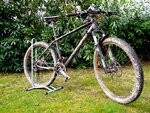Mike,
An 80 mile range is 5 hours at the Euro max-speed, 15 mph. So you have to spread 400 WH over 5 hours, leaving you with 80 watts constant drain on the battery. You need about 150 watts to push the bike, on the flat, no wind, at 15 mph. So even with 75% efficiency, the motor delivers 60 watts and you have to pedal at 90 watts. For anyone in good shape, that is doable. Maybe not for 5 hours, but that's not relevant.
Range numbers are worthless. Too many variables. You might as well say the bike is termite-proof. It's just as meaningful.
View attachment 2431
The bike calculator says you need 500 watts to get up that 18% grade at 6 mph. A hub motor is probably going to bog down and be terribly inefficient (or blow a thermal limiter). The mid-drive keeps you going. If you pedal fairly hard, you'd move fast enough. All you can do is throw some watts at the hill, deliver the watts efficiently.
George,
Yes, that is close to actual Strava info, 640W. I weigh between 165 and 185. Last time, I weighed 181. I easily lose 20 pounds when I run hard. I want to carry 50 pounds of food up the hill. My guess is somewhere between 750-1000W or 90-120 Nm, for total weight.
My goal is 9mph, which is wobble speed. A gyroscope(bike) is directing more energy up the hill, when stable. The pros push and pull hard on the handlebars to keep the bike stable when below wobble speed.
Thanks again, for pointing the Euro differences. Would Bosch and Yamaha both be using the same euro speeds? The Bosch battery distance charts are in german. I am under the impression 2015 Yamaha gets twice the battery distance. The best Bosch info is 175km under ideal and 80km under worst case conditions.
Inferring from the graphs, Bosch seems to be half Yamaha. Without explicit parameters, I just cannot draw accurate conclusions. The best info I have suggests 2015 Bosch is half Yamaha. My perception probably reflects the amount of variation, rather than electrical differences.
The Haibike brochure lists 25kph, 80RPM cadence and 20Nm foot torque for the Yamaha to get 130km from the battery at 100% assist. I will try to find the
equivalent Haibike XDuro(bosch) data.
The lack of standard performance presentation really annoys me! Obtaining useful, basic info is difficult and unreliable.
The key take-away is the information or personal interpretation is biased and risky to some extent. I need to keep the bias/risk foremost in mind when trying to determine cost-benefit of different brands. In other words, the information is noisy. So, conclusions need to be carefully qualified. As, Daniel Kahneman says, the human mind is a machine for jumping to conclusions. Based on the noise level of common eBike info, confidence levels should be kept low.
EBikes are more like string, then keyed, music instruments. Stringed instruments are flexible and have a great deal of variation in sound. Keyed instruments,like trumpets, are easier to measure, because the keys are fixed. The human element is still more variable than the instruments. As Daniel Kahneman's Nobel Prize winning work demonstrates, the human mind does not perceive the world as a regression-to-the-mean. The human mind is responsible for unrealistic interpretations.
On a scale from one to five, I rate the risk/bias of E-Bike information a four. Despite the fact that bike properties are described by numbers, the amount of flexibility and variation is large enough that confident conclusions are unlikely.
I feel bike components are over-emphasized at the expense of accurate benefit interpretations. The bias towards branded components results in error prone interpretations. Relating a feature (I.e., a component) to a benefit is difficult and inaccurate. The consumer wants to distinguish between the benefits different bikes provide. The information is presented in a way that does not facilitate meaningful interpretation. The meaning is literally lost in the translation from features to benefits.
EBikes are unlike motorcycles. The human mind has a difficult time accepting the fact that
human differences are as great as EBike differences. The human body has as large an influence on the final outcome as the machine. The distinction between man and machine is a blurred one.
In my personal case, I rely on experience. I run up an 18% road grade. I race bicyclists up the 10% grade and usually run faster than most bicyclists can pedal. I can reliably extrapolate that I need an eBike that borders on a motorcycle to comfortably ascend my 18% grade. If I tinker with a bike, I try to adapt a
scooter controller and motor in a bicycle.
I train on the hills by carrying 10-35 pounds of food in a fanny pack. Toe power is the trick to steep hill running. Strong toes ensure powerful and fast legs. When heels strike the ground and foot is not perpendicular to ground on push, more than 50% speed is lost, closer to 80%.
I weigh the fanny pack on the store counter scales once or twice a week. The clerks and I play a guessing game. Everyone is amazed by how inaccurate our judgments can be. I use the same fanny and/or backpack each time. Until I jam the food into the pack and lift the pack, nobody is able to accurately estimate the weight. Until we measure the pack, we are uncertain how accurate our estimate is. We usually guess +/- 2.5 pounds, or 5-10%.
Like Bono sings, "the best of us are geniuses of compression. The worst of us are a long, drawn-out confession."
Thank you,
Mike
PS Funny thing. I just started watching Howard Goodalls Story of Music. He opens by saying no jargon or misleading labels!


